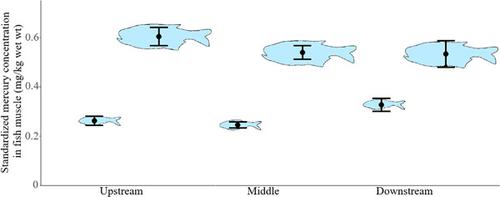当前位置:
X-MOL 学术
›
Environ. Toxicol. Chem.
›
论文详情
Our official English website, www.x-mol.net, welcomes your
feedback! (Note: you will need to create a separate account there.)
Biological Factors Moderate Trace Element Accumulation in Fish along an Environmental Concentration Gradient
Environmental Toxicology and Chemistry ( IF 3.6 ) Pub Date : 2020-11-17 , DOI: 10.1002/etc.4926 Caitlyn Donadt 1 , Colin A Cooke 2, 3 , Jennifer A Graydon 4 , Mark S Poesch 1
Environmental Toxicology and Chemistry ( IF 3.6 ) Pub Date : 2020-11-17 , DOI: 10.1002/etc.4926 Caitlyn Donadt 1 , Colin A Cooke 2, 3 , Jennifer A Graydon 4 , Mark S Poesch 1
Affiliation

|
Trace elements can accumulate in aquatic food webs, becoming potentially hazardous to wildlife and human health. Whereas many studies have examined mercury dynamics in freshwater environments, evidence for the bioaccumulative potential of other trace elements (e.g., arsenic) is conflicting. Trace element concentrations found in surface water of the Red Deer River, Alberta, Canada, have raised concern for potential accumulation in aquatic biota. We investigated fish from this river to better understand the influence of biological and environmental factors in trace element bioaccumulation. We analyzed 20 trace elements, and stable nitrogen (δ15N) and carbon (δ13C) isotopes, in the muscle tissue of 8 species. Zinc, selenium, arsenic, chromium, and nickel were detected in the majority of fish at low concentrations. However, mercury was detected in all fish and often exceeded criteria for the protection of consumers. Body size was often positively correlated with trace element concentrations. In addition, δ15N and δ13C were correlated to mercury and arsenic concentrations, indicating that mercury biomagnifies whereas arsenic biodiminishes. Spatial patterns of fish trace element concentrations did not reflect differences in surface water concentrations. These findings indicate that fish trace element concentrations are primarily moderated by biological factors, such as trophic position and body size, and are not locally restricted to areas of relatively high environmental concentrations in the Red Deer River. Environ Toxicol Chem 2021;40:422–434. © 2020 SETAC
中文翻译:

生物因素在鱼类中沿着环境浓度梯度适度积累微量元素
微量元素会在水生食物网中积累,对野生动物和人类健康构成潜在危害。尽管许多研究已经检查了淡水环境中的汞动态,但其他微量元素(例如砷)的生物累积潜力的证据是相互矛盾的。在加拿大艾伯塔省红鹿河地表水中发现的微量元素浓度引起了人们对水生生物群中潜在积累的担忧。我们调查了这条河中的鱼类,以更好地了解生物和环境因素对微量元素生物积累的影响。我们分析了 20 种微量元素,以及稳定的氮 (δ 15 N) 和碳 (δ 13C) 同位素,存在于 8 种肌肉组织中。在大多数鱼类中检测到低浓度的锌、硒、砷、铬和镍。然而,在所有鱼类中都检测到汞,而且常常超出保护消费者的标准。体型通常与微量元素浓度呈正相关。此外,δ 15 N 和δ 13C 与汞和砷的浓度相关,表明汞生物放大而砷生物减少。鱼类微量元素浓度的空间格局并未反映地表水浓度的差异。这些发现表明,鱼类微量元素浓度主要受生物因素的调节,如营养位置和体型,而不限于马鹿河中环境浓度相对较高的地区。环境毒理学化学2021;40:422-434。© 2020 SETAC
更新日期:2021-01-25
中文翻译:

生物因素在鱼类中沿着环境浓度梯度适度积累微量元素
微量元素会在水生食物网中积累,对野生动物和人类健康构成潜在危害。尽管许多研究已经检查了淡水环境中的汞动态,但其他微量元素(例如砷)的生物累积潜力的证据是相互矛盾的。在加拿大艾伯塔省红鹿河地表水中发现的微量元素浓度引起了人们对水生生物群中潜在积累的担忧。我们调查了这条河中的鱼类,以更好地了解生物和环境因素对微量元素生物积累的影响。我们分析了 20 种微量元素,以及稳定的氮 (δ 15 N) 和碳 (δ 13C) 同位素,存在于 8 种肌肉组织中。在大多数鱼类中检测到低浓度的锌、硒、砷、铬和镍。然而,在所有鱼类中都检测到汞,而且常常超出保护消费者的标准。体型通常与微量元素浓度呈正相关。此外,δ 15 N 和δ 13C 与汞和砷的浓度相关,表明汞生物放大而砷生物减少。鱼类微量元素浓度的空间格局并未反映地表水浓度的差异。这些发现表明,鱼类微量元素浓度主要受生物因素的调节,如营养位置和体型,而不限于马鹿河中环境浓度相对较高的地区。环境毒理学化学2021;40:422-434。© 2020 SETAC











































 京公网安备 11010802027423号
京公网安备 11010802027423号